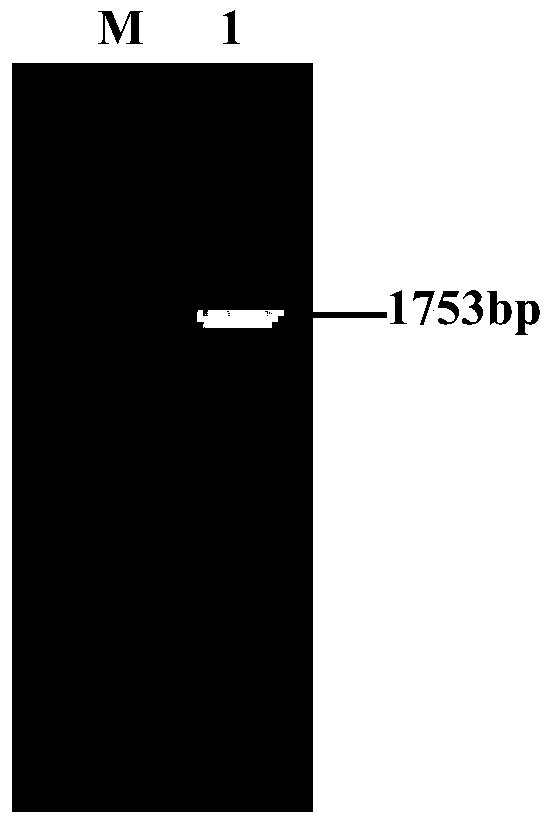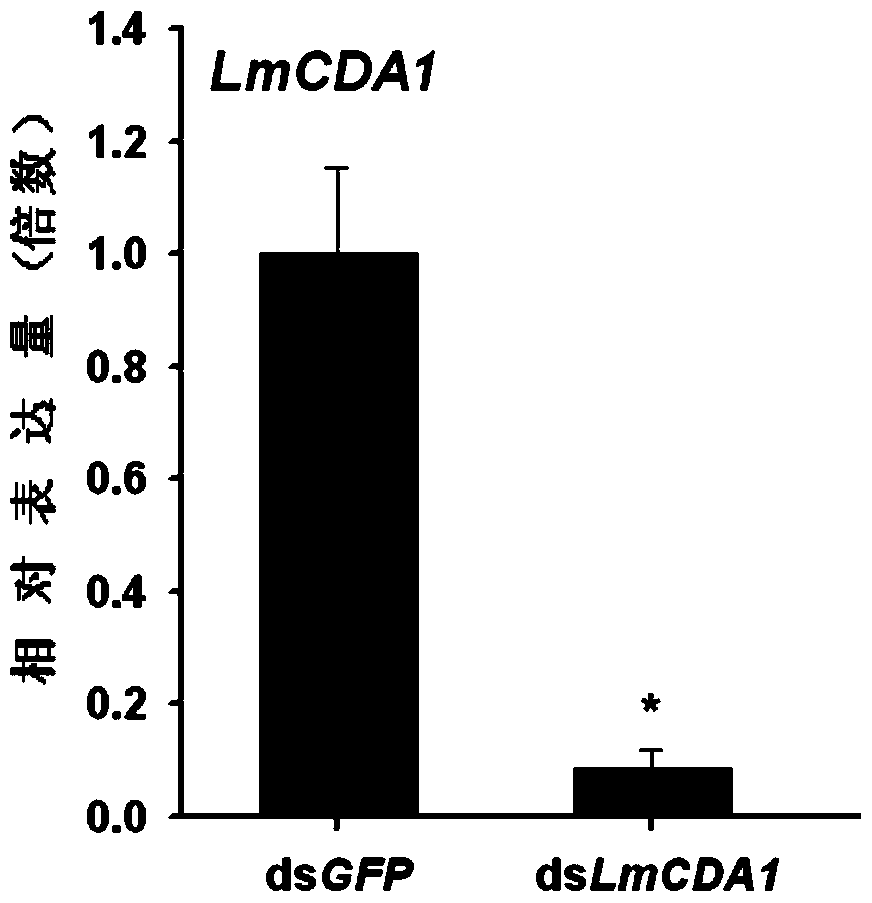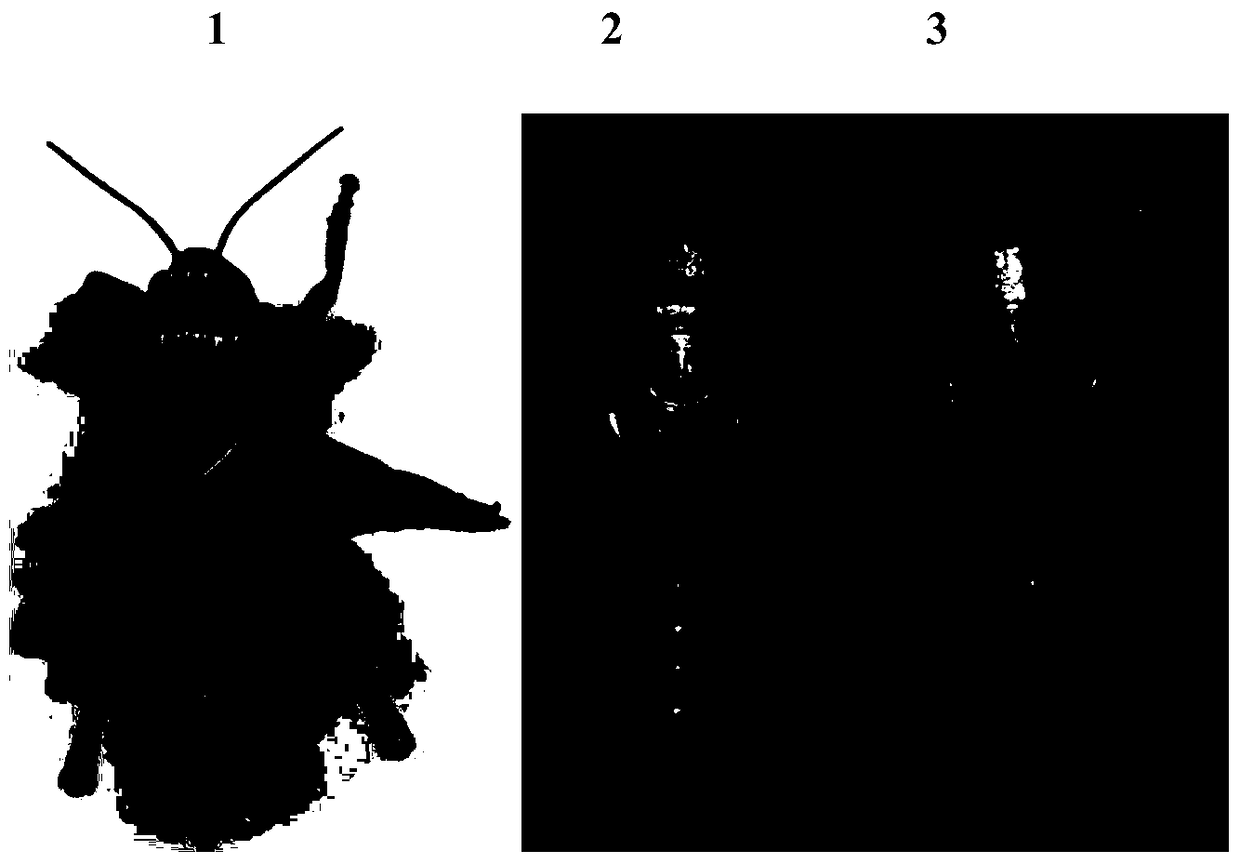Insect chitin deacetylase gene 1 and its application in pest control
An acetylase, chitin technology, applied in the application, genetic engineering, plant genetic improvement and other directions, can solve the problems of drug resistance, non-target biological hazards, environmental pollution, etc., and achieve the effect of high lethality
- Summary
- Abstract
- Description
- Claims
- Application Information
AI Technical Summary
Problems solved by technology
Method used
Image
Examples
Embodiment 1
[0013] Example 1: Acquisition of full-length cDNA sequence of migratory locust chitin deacetylase gene 1 and analysis of its amino acid sequence
[0014] 1. Acquisition of cDNA fragment of migratory locust chitin deacetylase gene 1
[0015] Based on the transcriptome database of migratory locusts, the Unigene was searched, and after NCBI Blastx analysis, a fragment of chitin deacetylase gene 1 of migratory locusts was determined to be obtained.
[0016] 2. Acquisition of full-length cDNA sequence of migratory locust chitin deacetylase gene 1
[0017] The above gene fragments were spliced by GeneDoc software, and primer premier5.0 software was used to design the upstream primer CAACGTCACAACCAGTGAGTGTC (SEQ ID NO: 3) and the downstream primer GCGGTACACGATGAAAGATGG (SEQ ID NO: 4), which were synthesized by Shanghai Yingwei Jieji Biological Co., Ltd. .
[0018] The 5th-instar migratory locust nymphs with healthy growth, uniform size, and half male and half male were selected, ...
Embodiment 2
[0021] Example 2: dsRNA synthesis of migratory locust chitin deacetylase gene 1
[0022] 1. Design of primers for chitin deacetylase gene 1dsRNA of migratory locust
[0023] Based on the chitin deacetylase gene sequence of migratory locust, it was designed using primer premier5.0 software. dsRNA primers were designed, the sequences of which were taatacgactcactatagggTCTGTAACGGCGAGAAGGAC (SEQ ID NO: 5) and taatacgactcactatagggCCATCATGGTGAACTGGTTG (SEQ ID NO: 6) (the part in italics is T7 promoter). All primers were synthesized by Shanghai Yingwei Jieji Biological Co., Ltd.
[0024] 2. Synthesis of specific dsRNA from migratory locust chitin deacetylase gene 1
[0025] Using the above chitin deacetylase gene 1 extraction plasmid as a template, PCR amplification was performed with upstream and downstream primers containing the T7 promoter sequence. A 586bp gene fragment (SEQ ID NO: 7) was obtained, and the PCR product was purified using the Gel Extraction Kit (Omega) kit accord...
Embodiment 3
[0026] Embodiment 3: dsRNA kills migratory locust experiment of migratory locust chitin deacetylase gene 1
[0027] 1. Specific dsRNA injection
[0028] A total of 28 5th-instar 2-day-old nymphs with healthy growth, uniform size, and half male and half male were selected for the experiment. 2.5 μl (6.25 μg) of synthetic dsRNA was gently injected into the flank between the second and third abdominal segments of the nymph using a 25 μl gauge microsyringe. At the same time, 28 nymphs were selected as the control group, and the same volume and concentration of dsGFP were injected into the control group. The injected migratory locusts were reared in a 30°C constant temperature biochemical incubator (light:dark time=14h:10h, temperature 30±2°C, humidity 60%), and fed fresh wheat seedlings and wheat bran every day.
[0029] 2. Detection of silencing of migratory locust chitin deacetylase gene 1
[0030]Nine nymphs injected with dsGFP and dsLmCDA124h were collected for total RNA ex...
PUM
 Login to View More
Login to View More Abstract
Description
Claims
Application Information
 Login to View More
Login to View More - R&D Engineer
- R&D Manager
- IP Professional
- Industry Leading Data Capabilities
- Powerful AI technology
- Patent DNA Extraction
Browse by: Latest US Patents, China's latest patents, Technical Efficacy Thesaurus, Application Domain, Technology Topic, Popular Technical Reports.
© 2024 PatSnap. All rights reserved.Legal|Privacy policy|Modern Slavery Act Transparency Statement|Sitemap|About US| Contact US: help@patsnap.com










